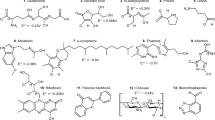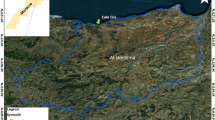Abstract
Alien plants have broad distribution throughout the world, in agriculture, forest,and natural areas displacing native vegetation, stunting or diminishing the growth, or development or establishment of native plants. Lantana is an annual invasive weeds of Verbenaceae (verbena) family, is native to tropical America while widespread in North America, many parts of Africa, Australia, and India. It tolerates a wide variety of abiotic conditions in the natural habitat. In order to gain insight into the biochemical basis of invasiveness of invasive alien species, in the present study, the abiotic stress condition-induced changes on reactive oxygen species contents (ROS) and ROS scavenging boiling stable antioxidant enzymes (peroxidase, superoxide dismutase (SOD), and catalase) were studied in three different most prevalent varieties of Lantana: pink (more invasive), red (moderate invasive), and violet (less invasive). Among all the enzymes studied, SOD was only detected as boiling stable. Indices of oxidative stress, superoxide radical and H2O2 content increased under low- and high-temperature conditions in a genotype- and tissue-dependent manner. For example, compared to other varieties, pink variety which is more invasive, showed higher ROS coupled with malondialdehyde contents under adverse abiotic conditions. As a result, it was postulated that pink genotype may have more efficient mechanism to scavenge ROS species as shown by the increase in boiling stable SOD(BsSOD) activity accompanied by enhanced accumulation of BsSOD isoenzymes. Based on the results, it can be inferred that plants which are more invasive may have more biochemical capacity to perform biological antioxidative reactions to combat abiotic stress-induced oxidative stress.





Similar content being viewed by others
References
Abedi T, Pakniyat H (2010) Antioxidant enzyme changes in response to drought stress in ten cultivars of oilseed rape (Brassica napus L.). Czech J Genet Plant Breed 46:27–34
Almeselmani M, Deshmukh PS, Sairam RK, Kushwaha SR, Singh TP (2006) Protective role of antioxidant enzymes under high temperature stress. Plant Sci 171:382–388
Apel K, Hirt H (2004) Reactive oxygen species: metabolism, oxidative stress, and signal transduction. Annu Rev Plant Biol 55:373–399
Arroyo AG, Flores JMC, Garciarrubio AC (2000) Highly hydrophilic proteins in prokaryotes and eukaryotes are common during conditions of water deficit. J Biol Chem 275:5666–5674
Asada K, Kiso K (1973) Initiation of aerobic oxidation of sulphite by illuminated spinach chloroplasts. Eur J Biochem 33:253–257
Baruah A, Simkova K, Apek K, Laloi C (2009) Arabidopsis mutants reveal multiple singlet oxygen signaling pathway involved in stress response and development. Plant Mol Biol 70:547–563
Bi YH, Chen WL, Zhang WN, Zhou Q, Yun LJ, Xing D (2009) Production of reactive oxygen species, impairment of photosynthetic function and dynamic changes in mitochondria are early events in cadmium induced cell death in Arabidopsis thaliana. Biol Cell 101:629–643
Biemelt S, Keetman U, Mock HP, Grimm B (2000) Expression and activity of isoenzymes of superoxide dismutase in wheat roots in response to hypoxia and anoxia. Plant Cell Environ 23:135–144
Bowler C, Van MM, Inze D (1992) Superoxide dismutase and stress tolerance. Annu Rev Plant Physiol Plant Mol Biol 43:83–116
Bradford MM (1976) A rapid and sensitive method for quantitation of microorganism quantities of protein utilizing the principle of protein-dye binding. Anal Bio 72:248–254
Brand-Williams W, Cuvelier ME, Berset C (1995) Use of a free radical method to evaluate antioxidant activity. LWT Food Sci Technol 28:25–30
Chakrabarty D, Verma AK, Datta SK (2009) Oxidative stress and antioxidant activity as the basis of senescence in Hemerocallis (day lily) flowers. J Hortic For 1:113–119
Chaves MM, Maroco JP, Pereira J (2003) Understanding plant responses to drought-from genes to the whole plant. Funct Plant Biol 30:239–264
Day MD, Wiley CJ, Playford J, Zalucki MP (2003) Lantana: current management status and future prospects. Australian Centre for International Research, Canberra
Edwards EA, Enard C, Creissen GP, Mullineaux PM (1994) Synthesis and properties of glutathione reductase in stressed peas. Planta 192:137–143
Elstner EF, Heupel A (1976) Inhibition of nitrite formation from hydroxyl ammonium chloride: a simple assay for superoxide dismutase. Anal Biochem 70:616–620
Ensbey R (2003) Managing Lantana. Agfact P7.6.42. NSW Agriculture, Orange, NSW
Gao CJ, Xing D, Li LL, Zhang LR (2008) Implication of reactive oxygen species and mitochondrial dysfunction in the early stages of plant programmed cell death induced by ultraviolet-C overexposure. Planta 227:755–767
Gill SS, Tuteja N (2010) Reactive oxygen species and antioxidant machinery in abiotic stress tolerance in crop plants. Plant Physiol Biochem 48:909–930
Goel A, Sheoran IS (2003) Lipid peroxidation and peroxide scavenging enzymes in cotton seeds under natural ageing. Biol Plant 46:429–434
Gong WN, Xie YB, Wan FH, Guo JY (2010) Molecular cloning, characterization, and heterologous expression analysis of heat shock protein genes (hsp70 and hsp90) of the invasive alien weed, Ageratina adenophora (Asteraceae). Weed Biol Manag 10:91–101
Gratao PL, Polle A, Lea PJ, Azevedo RA (2005) Making the life of heavy metal stress plants a little easier. Funct Plant Biol 32:481–494
Heath RL, Packer L (1968) Photoperoxidation in isolated chloroplasts I-Kinetics and stoichiometry of fatty acid peroxidation. Arch Biochem Biophys 125:189–198
Henkel SK, Hofmann GE (2009) Differing patterns of hsp70 gene expression in invasive and native kelp species: evidence for acclimation-induced variation. Dev Appl Phycol 2:465–474
Henkel SK, Kawai H, Hofmann GE (2009) Interspecific and interhabitat variation in hsp 70 gene expression in native and invasive kelp populations. Mar Ecol Prog Ser 386:1–13
Horling F, Lamkemeyer P, Konnig J, Finkemeir I, Kandlbinder A, Baier M et al (2003) Divergent light-, ascorbate-, and oxidative stress-dependent regulation of expression of the peroxiredoxin gene family in Arabidopsis. Plant Physiol 131:317–325
Hu X, Jiang M, Zhang A, Lu J (2005) Abscisic acid-induced apoplastic H2O2 accumulation up-regulates the activities of chloroplastic and cytosolic antioxidant enzymes in maize leaves. Planta 223:57–68
Ingram J, Bartels D (1996) The molecular basis of dehydration tolerance in plants. Annu Rev Plant Physiol Plant Mol Biol 47:377–403
Jacobsen JV, Shaw DC (1989) Heat-stable proteins and abscisic acid action in barley aleurone cells. Plant Physiol 91:1520–1526
Jiang M, Zhang J (2002) Water stress-induced abscisic acid accumulation triggers the increased generation of reactive oxygen species and upregulates the activities of antioxidant enzymes in maize leaves. J Exp Bot 53:2401–2410
Jung S (2003) The combined action of catalase (CAT) and superoxide dismutase (SOD) is critical in mitigating the effects of oxidative stress. Pestic Biochem Physiol 75:9–17
Kavas M, Baloglu MC, Akca O, Kose FS, Gokcay D (2013) Effect of drought stress on oxidative damage and antioxidant enzyme activity in melon seedlings. Turk J Biol 37:491–498
Lee DH, Lee CB (2000) Chilling stress-induced changes of antioxidant enzymes in the leaves of cucumber: in gel enzyme activity assays. Plant Sci 159:75–85
Li L, Yi H (2012) Effect of sulfur dioxide on ROS production, gene expression and antioxidant enzyme activity in Arabidopsis plants. Plant Physiol Biochem 58:46–53
Lu P, Sang W-G, Ma K-P (2008) Differential responses of the activities of antioxidant enzymes to thermal stresses between two invasive Eupatorium species in China. J Integr Plant Biol 50:1744–7909
McKersie BD, Bowley SR, Jones KS (1999) Winter survival of transgenic alfalfa overexpressing superoxide dismutase. Plant Physiol 119:839–847
Miller G, Shulaev V, Mittler R (2008) Reactive oxygen signalling and abiotic stress. Physiol Plant 133:481–489
Mittler R (2002) Oxidative stress, antioxidants and stress tolerance. Trends Plant Sci 7:405–410
Munne BS, Alegre L (2002) Interplay between ascorbic acid and lipophilic antioxidant defences in chloroplasts of water stressed Arabidopsis plants. FEBS Lett 524:145–148
Oser BL (1979) Hawks physiological chemistry. Mc Graw Hill, New York, pp 702–705
Pawlak S, Firych A, Rymer K, Deckert J (2009) Cu, Zn-superoxide dismutase is differently regulated by cadmium and lead in roots of soybean seedlings. Acta Physiol Plant 31:741–747
Pelah D, Shoseyov O, Altman A (1995) Characterization of BspA, a major boiling stable water stress responsive protein in aspen (Populus tremula). Tree Physiol 15:673–678
Sambrook J, Fritsch EF, Maniatis T (1989) Molecular cloning: a laboratory manual. Cold Spring Harbour Laboratory Press, New York, pp 18.64–18.75
Sanders RW (2006) Taxonomy of Lantana sect. Lantana (Verbenaceae): correct application of Lantana camara and associated names. Sida 22:381–421
Secenji M, Hideg E, Bebes A, Gyorgyey J (2010) Transcriptional differences in gene families of the ascorbate-glutathione cycle in wheat during mild water deficit. Plant Cell Rep 29:37–50
Sharma AD, Vasudeva R, Kaur R (2006) Expression of a boiling-stable protein (BsCyp) in response to heat shock, drought and ABA treatments in Sorghum bicolor. Plant Growth Regul 50:249–254
Sharma AD, Rakhra G, Kaur S, Kaur H (2013) Expression of boiling-stable peroxidase (PRX) isoenzymes under combined effect of drought and heat in different tissues of Triticum aestivum. J Agric Technol 9:901–913
Shigeoka S, Ishikawa T, Tamoi M, Miyagawa Y, Takeda T, Yabuta Y, Yoshimura K (2002) Regulation and function of ascorbate peroxidase isoenzymes. J Exp Bot 53:1305–1319
Smith LS, Smith DA (1982) The naturalized Lantana camara complex in eastern Australia. Qld Bot Bull 1:126
Terzi R, Kadioglu A (2006) Drought stress tolerance and the antioxidant enzyme system in Ctenanthe setosa. Acta Biol Crac Ser Bot 48:89–96
Thirupathi K, Jun-Cheol M, Changsoo K, Kumariah M, Wook K (2011) Reactive oxygen species in plants: their generation, signal transduction and scavenging mechanisms. Aust J Crop Sci 5:709–725
Tian Z, Wang F, Zhang W, Liu C, Zhao X (2012) Antioxidant mechanism and lipid peroxidation patterns in leaves and petals of marigold in response to drought stress. Hortic Environ Biotechnol 53:183–192
Tukendorf A, Rauser WE (1990) Changes in glutathione and phytochelatins in roots of maize seedlings exposed to cadmium. Plant Sci 70:155–166
Van Oosterhout E (2004) Lantana control manual—current management and control options for lantana (Lantana camara) in Australia. Queensland Department of Natural Resources, Mines and Energy, Brisbane
Wang WB, Kim YH, Lee HS, Kim KY, Deng XP, Kwak SS (2009) Analysis of antioxidant enzyme activity during germination of alfalfa under salt and drought stress. Plant Physiol Biochem 47:570–577
Yan J, Wang J, Tissue D, Holaday AS, Allen R, Zhang H (2003) Photosynthesis and seed production under water-deficit conditions in transgenic tobacco plants that overexpress an Arabidopsis ascorbate peroxidase gene. Crop Sci 43:1477–1483
Yang Y, Han C, Liu Q, Lin B, Wang J (2008) Effect of drought and low light on growth and enzymatic antioxidant system of Picea asperata seedlings. Acta Physiol Plant 30:433–440
Zerebecki RA, Sorte CJB (2011) Temperature tolerance and stress proteins as mechanism of invasive species success. PLoS ONE 6:e14806
Zhou S, Sauve RJ, Mmbaga MT, Frenkel C (2005) Cold induced antioxidant enzymes changes in Leucanthemum maximum ‘Silver Princess’. Hortic Sci 40:546–548
Acknowledgments
AD Sharma wants to thank DST, SERB, the Govt. of India for the grant for this research project.
Author information
Authors and Affiliations
Corresponding author
Electronic supplementary material
Below is the link to the electronic supplementary material.
Rights and permissions
About this article
Cite this article
Mamik, S., Sharma, A.D. Analysis of boiling stable antioxidant enzymes in invasive alien species of Lantana under abiotic stress-like conditions. Braz. J. Bot 37, 129–141 (2014). https://doi.org/10.1007/s40415-014-0060-7
Received:
Accepted:
Published:
Issue Date:
DOI: https://doi.org/10.1007/s40415-014-0060-7




